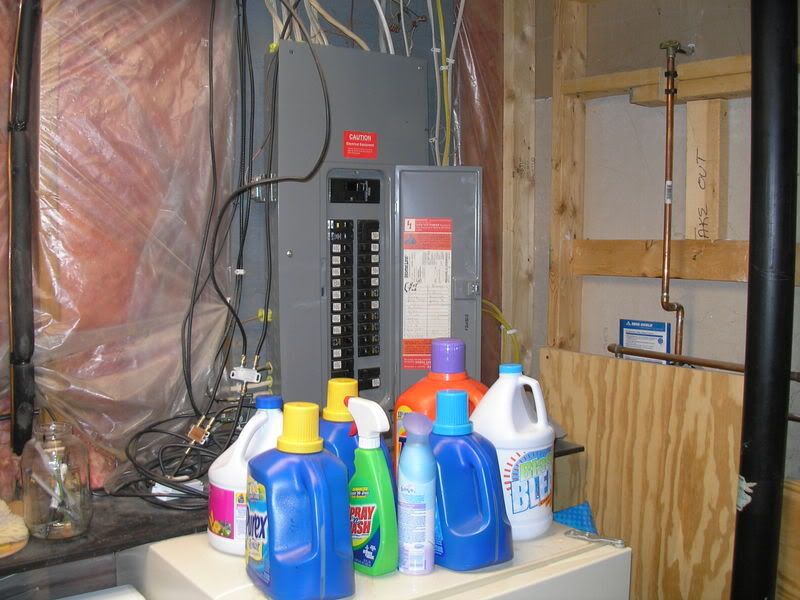As the definition of outlet in 2005 code would include a panel as an outlet.
I think you need to read the definition of "Device" which Don pointed out in post # 35.
Roger
As the definition of outlet in 2005 code would include a panel as an outlet.
Now someone is making sense!!Yeah, and the 9 or 10 hours you're in your home, you're actually alert because you can't tear yourself away from the Mike Holt Forum and go to bed....so this leaves only an hour or two at the most that you'd be sleeping (at the computer, of course) so the only AFCI protected thing in the house should be the computer.
I disagree. In the 24-plexes at the project I am working at, all the panels are located on interior walls. If I were choosing placement, I would favor interior walls so as to not interfere with insulation in the exterior walls.
The main reason I'd pick a bedroom wall is because the only walls left are in the living room (highly visible), bathroom (illegal), laundry (illegal - 110.26), and bedroom closet (illegal).
I dont have the 2008... can someone explain why laundry is illegal?
~Matt
Here in Michigan there are a lot of basements, and that's where the panel is usually located. And in front of a lot of the panels you will see clothes hanging on pipes rigged to the ceiling, installed water softeners, washers and dryers and laundry tubs etc...
110.26(F)(1)(a)And my favorite is water lines running directly above the panel. This includes fresh water and drain. :smile:
I think you need to read the definition of "Device" which Don pointed out in post # 35.
Roger
And that such a failure, if it were to occur while occupants are sleeping, carries a high risk of serious injury or death due to smoke, flames or flying panel covers;
The Article 100 definition of "Device" is ambiguous.I think you need to read the definition of "Device" which Don pointed out in post # 35.
I've only seen one in my 38 years. I personally would never put one in a
bedroom, let alone behind a door.
The Article 100 definition of "Device" is ambiguous.
A receptacle is a device.
A switch is a device.
Saying that a "panel is a device" is just as inconclusive with respect to whether an Outlet (Art. 100 Definition) is present.
I've only seen one in my 38 years. I personally would never put one in a
bedroom, let alone behind a door.
Post #35That was an excelent thought. Lets take it one step further. Would a panel be considered an outlet. Would it have to be all on arcfault. Even the feeder!
Post #58A panel is a device, not an outlet.
Post #61As the definition of outlet in 2005 code would include a panel as an outlet. 210.12(b) would take effect. You would have to arcfault everything in that panel.
Post #70I think you need to read the definition of "Device" which Don pointed out in post #35
Roger, you further make my "point" by stating that a "wirenut is a device".The Article 100 definition of "Device" is ambiguous.
A receptacle is a device.
A switch is a device.
Saying that a "panel is a device" is just as inconclusive with respect to whether an Outlet (Art. 100 Definition) is present.
The NFPA is the owner of the copyright and is the publisher of the NEC. You are the writer of the NEC through proposals that are acted on by panel members. Any of you could be a panel member through whatever organization you are involved in (I represent EEI). One of my good friends is Jim Dollard, with the IBEW, is on the panel with me. Some of you are involved with ABC while others are involved with IEC or the IAEI.. . . the NFPA decided that's where you should start AFCiing circuits. . .
I think he means this:

Not a problem. I'd just read through the thread, as I've been "away" for awhile, and I had the give and take fresh in my mind.I didnt mean to make you go back and read the whole thread for those posts which don't change what an "outlet" is.
No, as you see in the Quoted give and take I posted in #75, above, "Outlet" is brought up first, and then dismissed by saying that "a panel is a device, not an outlet". That's wrong. "Device" has nothing to do with whether an Outlet is present or not.Al, actually you're missing the point, "device" is not mentioned in 210.12 however "outlet" is,
While I agree that there are Devices considered "outlets" in Article 100, Outlets are not exclusive to Devices. The simplest: a soldered splice between branch circuit conductors and the conductors of a piece of Utilization Equipment. This soldered splice is an Outlet, yet there is no device present.read all of article 100 for what specific devices are considered "outlets", that is all you would need to worry about.
This soldered splice is an Outlet, yet there is no device present.

